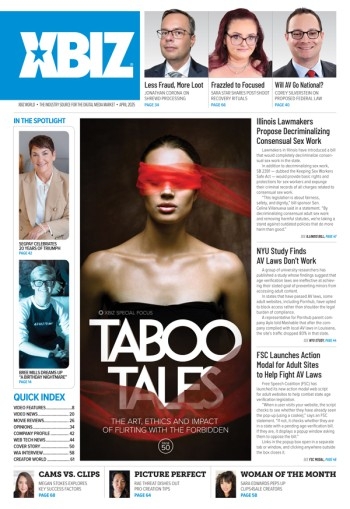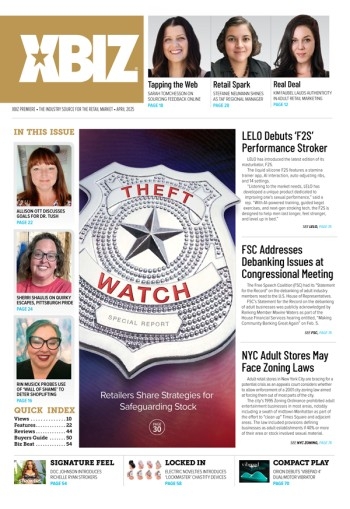We live in what has been called the Information Age, but for many of us, sometimes, it seems like the age of information overload. Never before have human beings been exposed to such a relentless deluge of data. Because of this, the task of "getting through the noise" to potential customers is becoming more and more difficult for all kinds of businesses, including adult entertainment companies. No wonder that companies that have effectively penetrated the market with their brands are almost always more successful and better equipped to survive economic hardships than those that don't.
Unfortunately, after many years of helping adult entertainment clients obtain and exploit their trademarks, experience has shown me that most of the entrepreneurs in the business are simply unaware of the value and importance of creating and protecting their brands through the acquisition and effective use of trademark rights available to them. So, in this month's column, we will take a brief look at some trademark basics that every adult entertainment entrepreneur should know.
Unfortunately, this article can only skim the surface of a very complex area of law and it is not intended to be a substitute for a visit with a competent trademark attorney.
Trademarks are a form of intellectual property that provide a trademark owner with a limited monopoly in the use of names, designs, logos, phrases and sounds associated with goods sold in commerce. Service marks provide the same type of protection for services. (For the purposes of this article I will use the term "trademark" generically to refer to both service marks and trademarks.) Because trademark rights constitute intellectual property, like real property (land, homes, office buildings, etc.) and personal property (cars, jewelry, equipment, etc.), intellectual property can be bought, sold, licensed, rented and can even function as security for bank loans.
Many adult entertainment companies own and exploit valuable trademarks. A few have made their trademarks the cornerstone of their branding and trademark licensing efforts. For these companies, their marks have become very valuable company assets that have helped set their companies apart from the rest of the industry. Playboy®, Hustler®, Digital Playground® and Vivid® are all good examples of adult companies that effectively exploit their brands through trademark licensing.
Virtually every product and service can be associated with a trademark. For example, adult entertainment companies can trademark a DVD line, such as Virtual Sex®; a contract star name, such as Jesse Jane®; entertainment services, such as Cybererotica®; affiliate program names, such as Max Cash®; and gentleman's club names, such as Spearmint Rhino®.
The primary purpose of a trademark is to identify the source of related goods and services, and to distinguish them from others in the marketplace. Consequently, the owner of a valid trademark can prevent another person from using that trademark or a confusingly similar mark to identify similar goods or services. Because of this, it is first important to determine whether you can rightfully use a desired name, design, logo, phrase, etc. in association with your products or services.
This inquiry is best made prior to committing resources to the launching of a product or service, or the commitment to packaging or advertising using a mark. Consequently, before you become wedded to a name, phrase, symbol, etc., I strongly recommend that you perform a "trademark search" and have the results evaluated by a competent trademark attorney.
Sadly, too often, clients come to us fully committed economically, and often emotionally, to a mark that already belongs to someone else.
Trademark rights can only be acquired by a party through the use of a mark in association with goods or services in commerce, unlike copyrights, which automatically belong to the authors of expressive works at the time the works are created. Another important distinction from copyrights is the fact that copyrights have a limited duration (currently for the life of the author plus 100 years), whereas there is no set term for trademark rights. The rights can theoretically continue forever because they are principally tied to the mark's continued use in commerce.
The potentially unlimited duration of trademark rights provides one of the major asset and wealth-building benefits provided by trademark ownership. The trademark for the famous British insurer "Lloyd's of London," for instance, has been in use for several hundred years, and the American company "Coca-Cola" registered its first trademark on January 31, 1893. Each mark is worth billions of dollars.
A party does not have to register a name, a logo or a design with any governmental entity to obtain rights in a trademark. In fact, "common-law" trademark rights may be acquired by a person or entity through the use of a mark in association with goods or services sold in commerce.
Common-law trademark rights are generally limited to geographic locations in which the goods or services bearing the mark is marketed or sold, and there are a number of requirements that must be satisfied before a party can obtain common-law trademark rights.
For example, one requirement is that no one else is using the same or a confusingly similar mark in association with goods or services similar to those you want to associate with the mark.
Another requirement is that the mark must be capable of operating as the identifier of the source of the goods or services with which it is associated. For example, to operate as a source identifier, the mark cannot be a generic term for the goods of service. Thus, words like "car" or "vehicle" in association with automobiles would not provide this function and generally cannot acquire trademark status for cars.
However, both words could be used as trademarks to identify other types of products not related to automobiles, such as clothing, for example.
Common-law trademark rights resulting from commercial use of the mark is more likely when the use of the word, phrase, logo, etc. clearly indicates the user's intent to use them as trademarks.
This is one of the reasons why you will often see the notation "TM" for trademark or "SM" for service mark, in association with branding of products or services. Such notice says to the world that the user is attempting to appropriate the word or term as their trademark or service mark for the associated goods and services.
In doing so, the notice also warns potential users of the mark or a confusingly similar mark that such use might violate the trademark owner's rights and subject them to trademark infringement litigation and possible payment of damages.
A party can also commence the process of acquiring trademark rights in the U.S. even before the mark is commercially used in association with any goods or services.
The process requires the filing of an "Intent To Use" (ITU) application for federal trademark registration with the U.S. Patent and Trademark Office (USPTO). The USPTO is the agency that is responsible for granting statutory trademark rights under federal law. (The USPTO maintains a very informative and user-friendly website at www.uspto.gov. The site also allows you to search the USPTO's registered trademark database and even file trademark applications online.)
The ITU application is very useful because it enables the applicant to establish a priority filing date and rights in the trademark if the mark is approved for registration by the USPTO.
This is so, provided that the applicant begins to actually use the mark in commerce in the manner represented in the application, and an acceptable Statement of Use is filed with the USPTO within three years of the issuance date of a Notice of Allowance to the applicant.
Acquiring such a priority date can be critically important if there is even a moderate amount of time between a company's commitment of resources to the use of a mark that has cleared the search process and the actual use of the mark in commerce.
This is because, without the priority date, the company's entitlement to rights in the mark will remain at risk and vulnerable to a third party's potentially superior claim to rights in the mark, if the third party acquires common-law rights through actual use, or the party first files its own ITU, before the company.
If the trademark applicant properly acquires a priority date through an ITU application, the priority date becomes the effective date for determining whether a third party has superior entitlement to registration of the mark.
Rights With Registration
Federally registering a company's trademark(s) can provide a number of important benefits, including:
- Exclusive ownership of the mark across the entire country (except in any area in which someone was previously using the same or a confusingly similar name or logo).
- Refusal by the Trademark Office to register potentially confusing marks in connection with goods or services that are identical or similar to the registered mark.
- The right to use the symbol ® in connection with your goods and services after registration has been granted.
- After five years of continuous use after registration, a designation that your mark is "incontestable" (i.e., the mark may not be challenged on the grounds that it is "descriptive" or lacks required "secondary meaning").
- Public notice of your registration to other users, notifying them of your superior rights to the mark.
A trademark registered in the U.S. can also provide a priority date for trademark applications in foreign countries. Obtaining trademarks in foreign countries is increasingly important in a wired world. In addition, trademark registration can make an important difference in litigation. For instance, if you have a registered trademark, then you are presumed to be the legitimate owner.
The burden is on the other party to prove that you are not. A valid trademark registration may increase the likelihood that you will prevail in a dispute regarding an Internet domain name comprising the trademark or a confusingly similar variant.
Unlike common-law marks, federal trademark registration also gives you nationwide rights in the mark instead of only where the mark has actually been used in commerce. Additionally, in the event of a trademark infringement action, federal registration entitles the trademark owner to recover up to three times the amount of actual damages, and attorney's fees, resulting from willful infringement of the mark.
In general, a trademark application requires that all of the following be submitted to the to the USPTO:
- The name of the applicant;
- A name and address for correspondence;
- A clear representation of the mark;
- A listing of the goods or services which are or will be identified by the mark; and
- The filing fee for at least one class of goods or services.
As previously indicated, trademark applications may be filed online without the assistance of an attorney. In many cases, small business owners can save money by filing their own trademark registrations.
But if you are considering the filing of an application yourself, please read the materials provided on the USPTO website carefully. It is also particularly important to understand the requirements associated with the disclosure of the goods and/or services associated with the mark. This part of the application is critically important and the identification of goods or services cannot be expanded after the application for the mark is filed.
With respect to specimens you provide to the USPTO, it is very important to remember that if you are mailing materials to the government for registration you should be sure that the works you send are fully compliant with all the laws pertaining to the works, including the federal labeling requirements pursuant to 18 U.S.C. §2257 et seq. In addition, you should also be sure that the specimens of use you provide to the USPTO are not offensive.
While the USPTO website allows you to file your own trademark registration application, the process can get complicated.
Consequently, the foregoing information is intended to only provide you with a general understanding of trademark registration procedures. It is not intended to be an exhaustive tutorial regarding all of the requirements pertaining to trademark registration. I strongly advise that you seek the advice of competent counsel, specifically an attorney experienced in trademark registration matters, and preferably one that has registered marks for adult entertainment businesses.
Greg Piccionelli is one of the country's most experienced Internet and adult entertainment business attorneys. He can be reached at Piccionelli & Sarno at (310) 553-3375.







